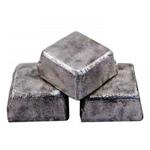How to Isolate Lanthanum from Minerals?
May 29,2024
Lanthanum is the third most abundant of all the lanthanides, making up 39 ppm of the Earth's crust, after neodymium at 41.5 ppm and cerium at 66.5 ppm. Notwithstanding being among the so-called "rare earth metals," lanthanum is hence not that rare at all, but it is historically so called since it is rarer than the "common earths" such as lime (Ca) and magnesia (Mg), and historically only a limited number of deposits were known. Lanthanum is considered a rare earth metal because the method to mine it is difficult, time consuming, and expensive. It is rarely the main lanthanide found in the rare earth minerals, and in their chemical formulae it is usually preceded by cerium.

Figure 1. Florencite-(La), LaAl3(PO4)2(OH)6, grayish-blue spindly and formless crystals growing outward from a matrix of botyroidal goethite, FeOOH. Overall 1.5 cm.
Here are the steps of isolating the lanthanum from minerals:
The first step involves, after the ore has been crushed and ground, treatment with hot concentrated sulfuric acid, evolving carbon dioxide, hydrogen fluoride, and silicon tetrafluoride. The resulting product is subsequently dried and leached with water, leaving the early lanthanide ions, including lanthanum, in solution.
The process for monazite, which typically contains all the rare earths as well as thorium, is more complicated. Monazite, due to its magnetic properties, can be isolated by repeated electromagnetic separation. After this separation step, it is then reacted with hot concentrated sulfuric acid to form water-soluble sulfates of the rare earths. The acidic filtrates are partially neutralized with sodium hydroxide to pH 3-4. As a result, thorium precipitates out of solution as its hydroxide, which can then be removed.
In the next step the solution is reacted with ammonium oxalate to convert the rare earths to their insoluble oxalates. The oxalates are converted to oxides by heating. The oxides are subsequently dissolved in nitric acid that excludes one of the main components, cerium, whose oxide is insoluble in HNO3. Lanthanum is isolated as a double salt with ammonium nitrate through crystallization. This salt is relatively less soluble than the other rare earth double salts and therefore stays in the residue. One has to be careful when handling some of these residues as they may contain 228Ra, the daughter product of 232Th, which is a strong gamma emitter. Lanthanum is comparatively easy to isolate as it has only one neighboring lanthanide, cerium, which can be removed using its ability to be oxidized to the 14 state; subsequently, lanthanum may be separated out by the classical process of fractional crystallization of La(NO3)3·2NH4NO3·4H2O, or by ion exchange techniques when higher purity is needed. Lanthanum metal is obtained from its oxide by heating it with ammonium chloride or fluoride and hydrofluoric acid at 300°C-400°C to produce the chloride or fluoride.
- Related articles
- Related Qustion
Supplementation with pyridoxal 5'-phosphate monohydrate can synthesize neurotransmitters such as dopamine and serotonin, maintaining a healthy nervous system.....
Nov 4,2025Biochemical EngineeringThe leading application of Palladium (Pd) currently is in catalytic converters. Pd is also utilized in jewelry, dentistry, watch-making, blood sugar test strips, aircraft spark plugs, surgical instruments, and electrical contacts.....
May 29,2024Inorganic chemistryLANTHANUM
7439-91-0You may like
- Lanthanum Metal
-

- $10.00 / 50kg
- 2024-12-24
- CAS:7439-91-0
- Min. Order: 50kg
- Purity: 99.9-99.99%
- Supply Ability: 200 tons per month
- LANTHANUM
-

- $10.00 / 1KG
- 2023-07-19
- CAS:7439-91-0
- Min. Order: 1KG
- Purity: 99%
- Supply Ability: 100MT/Month
- LANTHANUM
-

- $10.00 / 1KG
- 2021-10-19
- CAS:7439-91-0
- Min. Order: 1KG
- Purity: 99%
- Supply Ability: 20 tons






